This week on Legion’s Landing, Kristen takes the new Brawl deck Commander Syr Gwyn, Hero of Ashvale and upgrades her to a full powered EDH build. You can find her previous article on brewing for Brawl format here.
Like many people, I’ve gone out and bought the new Brawl decks primarily because they excite me as a Commander brewer. I’ve had some great fun playing Brawl, and can’t wait until I can play some 1v1 on Arena (seriously, when is that?).
Recently however I’ve been testing out Syr Gwyn in Commander. The gloves are off, the challenge has been initiated—how does this new Mardu hero stack up? Is it best to go tribal or Voltron? How many cards make the cut from the pre-con? Let’s jump into it.
Syr Gwyn, Hero of Ashvale
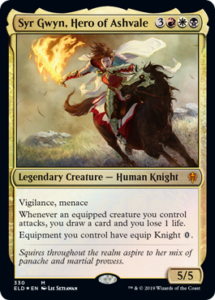
Last time around we looked at this card through the lens of Brawl. When looking at Commander, there’s a couple of things that stand out that we can think more about. The first is the free equip cost. Cards like Sunforger, Heartseeker, and Argentum Armor suddenly become even more playable. That’s something I can get behind.
The second is that EDH is a faster format with more efficient removal. For that reason, we must enable our General to attack the turn she comes into play while protecting our six-mana investment from interference.
Quest for the Holy Deck List
In Brawl, we don’t have access to some of the best Knights available. In Commander, we do! Efficient and powerful creatures like Knight Exemplar, Puresteel Paladin and Mirran Crusader, plus exciting Legendary Creatures like Vona, Butcher of Magan, Danitha Capashen, Paragon and Balan, Wandering Knight.
It’s probably easy to build a Knight tribal deck given the wealth of options, but there’s something dissonant about using Syr Gwyn to lead that charge. Generally speaking, a deck that cares about equipment runs at the least ten, plus ways to tutor those equipment out of the deck, plus ways to build around that. When you factor in artifact synergies, draw-based synergies like Sram, Senior Edificer, and protection for your creatures on top? You actually don’t end up with much space for a tribal synergy underneath, at least not in the purest sense of it.
Knight tribal would best be put in the hands of Commanders like Aryel, Knight of Windgrace, Sylvia Brightspear & Khorvath Brightflame, or big daddy Edgar Markov with a vampire-knight tribal approach. These decks reward you for going wide, and make best use of anthem effects. Trying to shoehorn those types of cards into an equipment-based build will lead to a lot of dead draws and suboptimal synergies. We’re going tall, not wide.
That’s not to say that I’m not focusing on knights for Syr Gwyn, though. On the contrary, the free equip cost for knights will definitely factor in to the creature choices in the deck. More than that, though, I am focusing on creatures that wear equipment well, or give us some kind of mana or card advantage—or even removal, in the case of Cavalier of Dawn.
One last word on the process for putting together a deck like this: don’t you dare skimp on lands. It might be tempting to run lots of artifact ramp, and rely on the free-equip ability to cheat mana. This is incorrect, as our Commander costs a hefty six mana to get into play. We want to be able to do this as fast as possible, and missing land drops is the last thing we need. Thirty-seven lands is where I have settled, but you could argue for 38.
The Deck
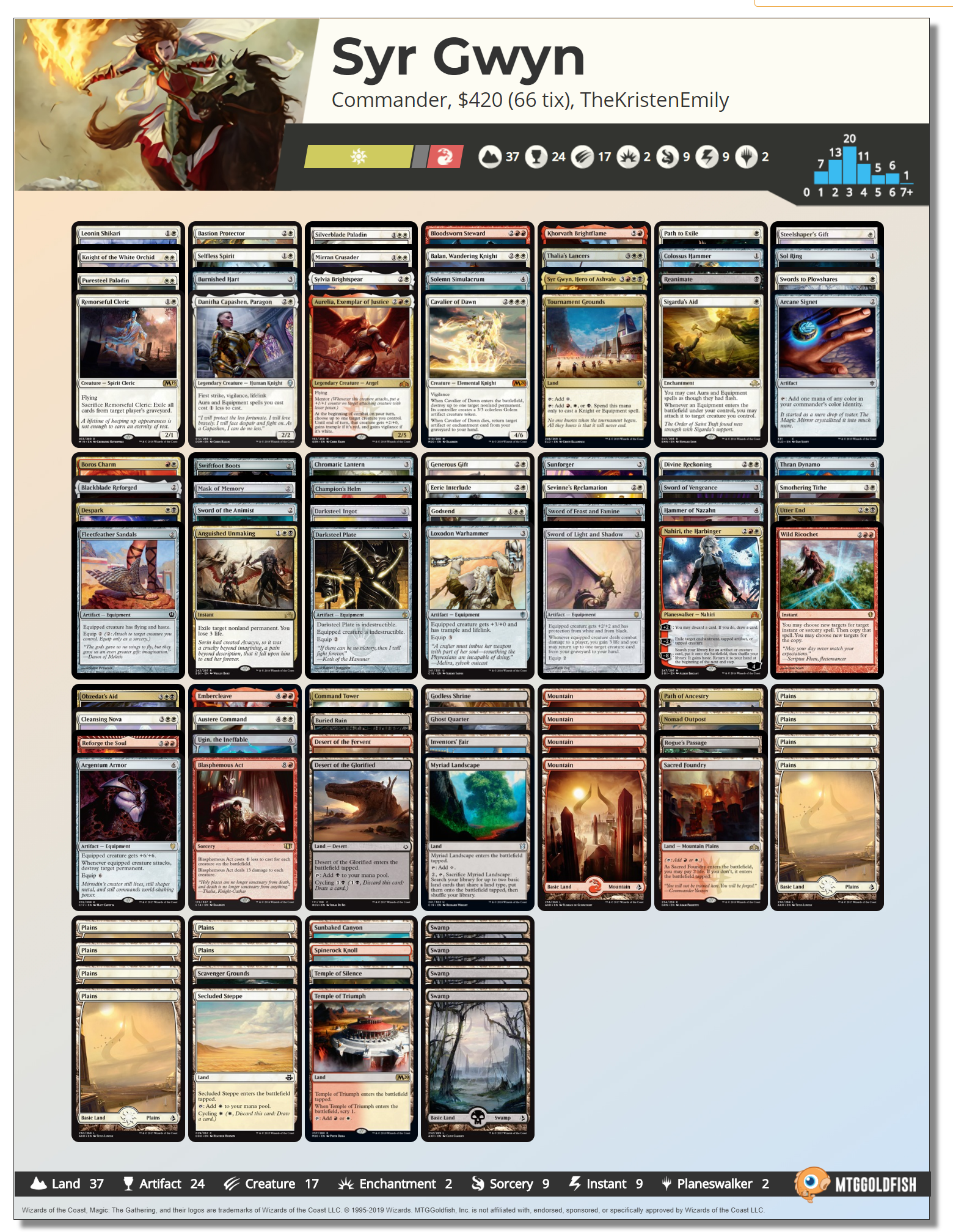
The deck runs in at $420, most of which is taken up by the blazing selection of equipment.
Ahem.
The long and short of it is that if you wish to make the leap to making a semi-competitive Syr Gwyn EDH deck, you’re going to have to splash out on some of the better equipment. It’s certainly possible to run the deck with cheaper replacements, but there’s nothing quite like Sword of Feast & Famine. (When I say semi-competitive, I mean in the purest sense that it can win games. I’m in no way insinuating this is able to compete at a cEDH table!)
Ported over from the precon are Tournament Grounds, Godless Shrine, Temple of Silence, Command Tower, Arcane Signet, and Colossal Hammer. If you’ve ever played within the Mardu colors, or played equipment-based decks before, you likely have a lot of the additions in your collection. If you haven’t, I suggest the following replacements, especially if you’re on a budget:
- Open the Armory instead of Steelshaper’s Gift ($10), Enlightened Tutor ($30) or Stoneforge Mystic ($70+)
- Sram, Senior Edificer over Puresteel Paladin ($15)
- Miraculous Recovery over Reanimate ($10)
- Mask of Avacyn over Champion’s Helm ($15)
Deck Breakdown
Let’s cover the foundations before we get on to the flexible slots. We’ll begin, as ever, with Ramp, Draw, Removal, and Recursion.
Ramp
We have one expensive Commander. Let’s make sure we can cast it. We start with Sol Ring, Arcane Signet, Chromatic Lantern, and Thran Dynamo. These give bursts of mana to hit thresholds quicker or fix our colors well—key in a mainly White deck that dips into Black and Red. Smothering Tithe also makes an appearance—great card, and exactly what the deck needs. If we’re lucky enough to Reforge the Soul, we’ll be laughing.
Mana rocks can be fragile, though, so we also have some more resilient options. Darksteel Ingot sticks around, whilst Myriad Landscape, Sword of the Animist, Solemn Simulacrum, and Burnished Hart pull lands out of our deck. Any non-green deck should probably play these universal ramp sources, and we get to add Knight of the White Orchid to round things out. Don’t forget that our Knight can grab Godless Shrine or Sacred Foundry.
We also have Sword of Feast & Famine. It is perhaps the strongest piece of equipment in the game, essentially doubling your mana production. If you buy just one expensive equipment, buy this.
Draw
We’re hoping that most of the top-ups to our hand will come from our Commander’s latent ability, but that’s not always going to be an option. With draw in the command zone we can go a little lighter than usual, but not by much. Aside from cycling lands, we have Mask of Memory, Reforge the Soul, Puresteel Paladin, Sunbaked Canyon, and Spinerock Knoll.
Nahiri, the Harbinger and Ugin, the Ineffable can also provide repeatable card draw, though their other abilities will probably be used more.
Rounding out our card advantage are our tutors. Inventors’ Fair, Steelshaper’s Gift, and Thalia’s Lancers get what we need when we need it. The Lancers in particular are everything this deck wants, giving us access to a bunch of different Legendary effects, from removal to draw to protection to outright damage.
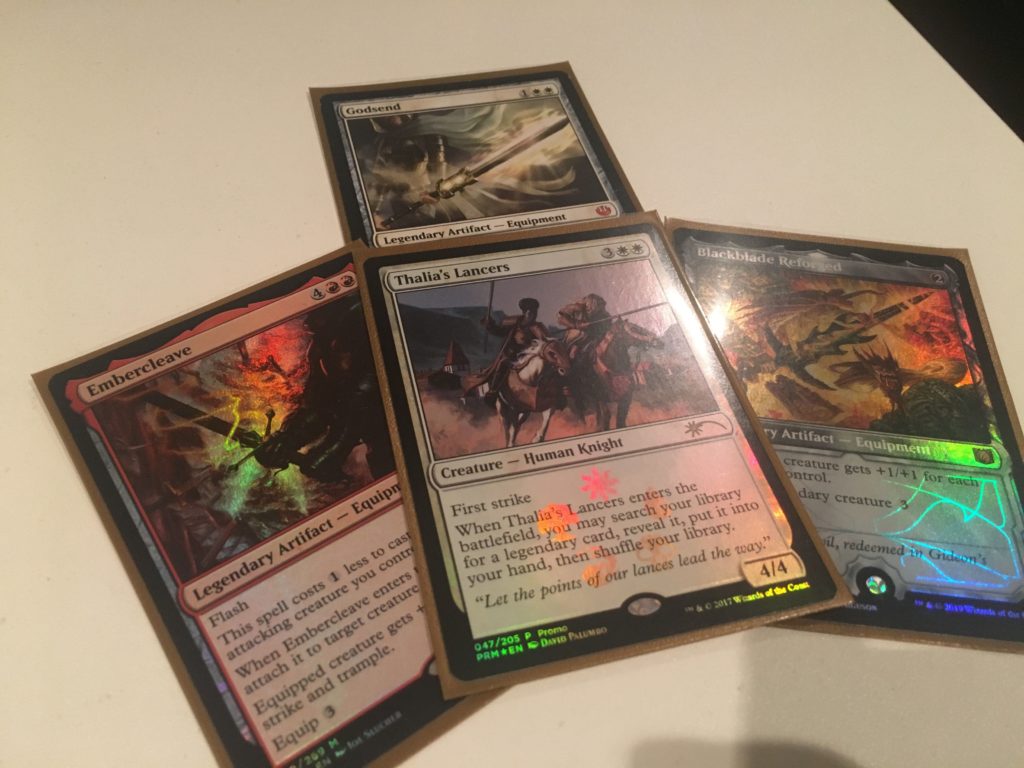
You want me to go and get which Sword? From which Stone?
Removal
Our removal package is designed to be as flexible as possible. We’re running Sunforger, which means our Commander lets us hit the panic button with reckless abandon. At instant speed, we have Swords to Plowshares, Path to Exile, Despark, Anguished Unmaking, Generous Gift, and Utter End. I’ve chosen to forgo the extra value of Return to Dust or Wear // Tear in favor of increased flexibility by using black mana. Whilst this does limit us, consider the fact that our Commander is a Mini-Nuke. If things are looking rough, we can remove the player.
Rounding out our indiscriminate removal package are Cavalier of Dawn, Ugin, the Ineffable, and Argentum Armor, which is ridiculous on turn six or seven. Remorseful Cleric joins Scavenger Grounds as our graveyard interaction, giving us a nice early evasive creature to equip as a bonus.
We can wipe the board with Austere Command, Cleansing Nova, Blasphemous Act, and Divine Reckoning. The former white spells give us a lot of flexibility; and, when combined with Boros Charm or Eerie Interlude, allow us to remain unscathed.
Divine Reckoning allows us to free up the board for Syr Gwyn. If people have one creature left, it can’t block Syr Gwyn alone! The flashback is gravy.
Recursion
Let’s face it: we’re playing Voltron, and people are going to run scared. Chances are our best equipment will be stripped away from us, and our Commander will be at death’s door before long. We can’t let this happen too many times, as the cost of Syr Gwy becomes prohibitive. For this reason, we run black-based recursion, either efficient like Reanimate or flexible like Obzedat’s Aid. Sword of Light & Shadow lets us re-use our support creatures (or dig out Syr Gwyn), and Buried Ruin rebuys Blackblade.
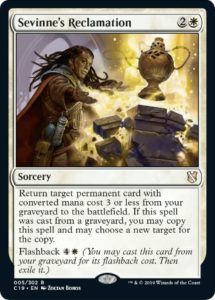
The star of this category for me though is Sevinne’s Reclamation. I’ve had my eye on this since Commander 2019, and it’s an absolute powerhouse in this deck. Watching opponents groan as you bring your star equipment back not once but twice is incredible, and the second time you can even bring back two. Absolutely include this card.
Your Horse, my Lord
Every good Knight needs a good squire. We’d be doing a disservice to Syr Gwyn by not ensuring her loyal steed is ready at a moment’s notice. I mentioned before how haste and protection are key to any good equipment deck, so let’s see what’s in the stables.
Bloodsworn Steward buffs our Commander up to the magic 7/7 statline, and grants haste to boot. Speaking of boots, we have both Swiftfoot Boots and Fleetfeather Sandles.
Akroma’s old sword, the Sword of Vengeance, grants Syr Gwyn all of the tasty abilities she wants: first strike, vigilance, trample, and haste, with a bonus +2/+0. Usually this is a card I would avoid due to the high equip cost, but for three mana I’m more than happy to take it over Chariot of Victory.
I’m not sure how we managed to fit a dragon in the stables, but Khorvath Brightflame is home to roost. Launching into play and lifting Syr Gwyn over the competition in a pinch is a boon, and the universal granting of haste and flying to our other knights is not to be sniffed at. Plus, he draws a card. Whilst it might be the same card every time, it’s still a good one: Sylvia Brightspear.
Swiftfoot Boots aren’t enough to protect Syr Gwyn on their own, though, so we’re also running a suite of protection effects. Champion’s Helm, Hammer of Nazahn, and Darksteel Plate round out the armory, with the former two also getting us to the magic seven power. Plus we can grab Boros Charm, Eerie Interlude, and Wild Ricochet from our Sunforger.
Don’t leave home without Selfless Spirit and Bastion Protector either. Both do a lot of work for us, and like Remorseful Cleric, Selfless Spirit is a great early body for equipment.
We also run Sigarda’s Aid. I don’t think it needs an explanation, but suffice to say equipping Colossus Hammer at instant speed is good enough to see low-tier play in Modern.
Supporting Cast
We can’t expect Syr Gwyn to shoulder all of the burden. We need other creatures to help us draw more cards and swing for more damage. Between Sylvia Brightspear, Mirran Crusader, and Silverblade Paladin you’ll be doing a lot of damage in the early to mid game, and scoring extra damage triggers with equipment.
Danitha Capashen helps mitigate the life loss from drawing cards and damage from go-wide tactics any opponent might want to try. She also reduces the cost of playing equipment, which means we can sometimes dump all our toys into play, especially combined with Ugin.
Balan, Wandering Knight is a great lieutenant. Functioning as a backup if we don’t have Syr Gwyn in play to reduce equip costs, paying 1W at instant speed can ruin blocking for our opponents. Further still, Leonin Shikari lets us perform some real acrobatics. Spot removal is ineffective when you can move the protection around.
Finally, Aurelia, Exemplar of Justice has an honorable position in the deck. I mean, she’s an Exemplar of Justice—that’s enough for knighthood, right? Aurelia actually does a lot of work in this deck. She can give our early creatures a stat boost, and is a vigilant-trampler in the air. That’s the right combination of abilities to wear equipment!
I’ve also noticed she draws a lot of hate from the table. I think she’s slightly less good than people think, but I’d much rather she takes a hit for Syr Gwyn, so I’m fine with that.
Let’s not forget, too, that we have further Knights that have already been mentioned: Bloodsworn Steward, Cavalier of Dawn, Thalia’s Lancers, Puresteel Paladin, and Knight of the White Orchid will all allow free equips. Honestly though, we’re more excited about the card draw, which only requires an equipped creature. It’s for this reason the deck runs so many non-Knights that help us with our strategy.
That’s a Lot of Damage
We’ve covered how the deck works. We’ve looked at the engine, the enablers, and the support. Now let’s look at the juicy parts.
Much like Aragorn in The Two Towers, we’ll often be in a position where we’re screaming at Syr Gwyn to “bring him down. Bring him down!” as a combo-player looks to be ready to dismantle our position.

In those cases, we need big damage. Between Blackblade Reforged and Colossus Hammer, it’s possible to take down an opponent with relative ease. With both you can delete a player—it’s absurd. Sometimes you must overcommit in these cases, as the benefits of taking a problematic deck out of the game can outweigh the cons of playing out your hand to do it. If we do overcommit, Loxodon Warhammer can gain some life back if things turn sour.
We also have access to the new equipment from Throne of Eldraine, Embercleave. It gives double strike, trample, and a small buff, and can come in at instant speed. It’s a great combat trick, but a solid inclusion otherwise. It’s the main reason we’re forgoing Sword of Fire and Ice; between the pro-red being a complete non-bo with Embercleave, and the fact that any equipment draws cards, it was on the chopping block.
Finally, if our opponents are blocking too much, we have Godsend. Godsend can remove blockers—handy if we have trample—turning Syr Gwyn into a black hole for anything coming our way.
If that’s not enough, Rogue’s Passage ignores the blocking step entirely.
The Strategy
We can reasonably expect to be attacking with two creatures at once. You’ll usually be between one and three, but rarely have a full board.
Early game, prioritize opening hands with lands, ramp, and an equipment. It doesn’t matter too much which equipment as long as it’s relatively cheap—we want to get our Commander into play as soon as possible, and start drawing cards from our Knights as soon as possible too.
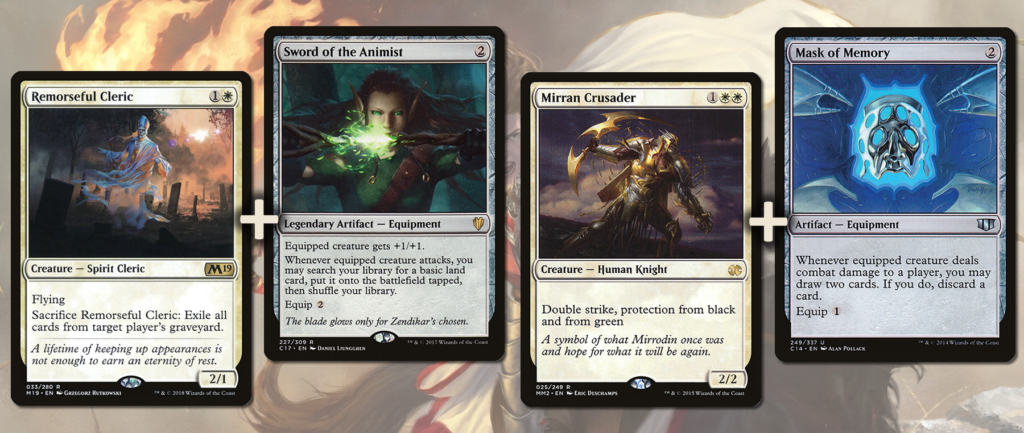
Our early drops can wear equipment well, given their tendency toward either evasion or double strike, which gives us additional triggers for connecting. Even when considering you’ll be paying to equip them before turn six, these are the most efficient wielders we can play early.
Haste and protection are our next ports of call, even before damage. There’s no point spending six mana if you can’t do anything with it, so sometimes it’ll be correct to hold back on casting Gwyn if we have haste or protection in hand. Instead, wait until opponents are tapped out.
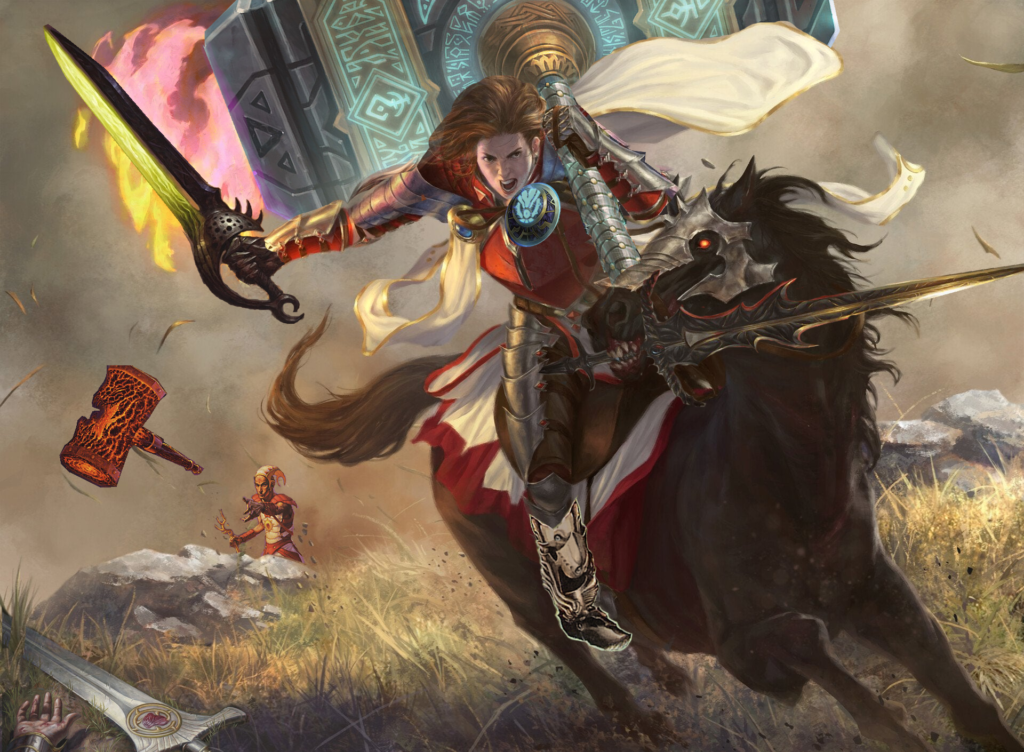
How is that horse still standing?
Syr Gwyn is more than capable of finishing players in two hits, and if left unchecked, can one-hit K.O. with ease. Go after players that look to have a lot of removal. Protection makes this interesting. Sometimes it’s correct to leave the Golgari player alone while Syr Gwyn is safe to harass the others with Feast & Famine, but sometimes it is better to silence them completely if given the chance. The biggest mistake I see aggro/creature based players make is not “using” their damage when they have it. Damage is a resource. Don’t be a coward.
As we’re leaning into Black mana, I embraced the ambition this takes and decided to go full tilt into some of the more powerful effects available. Unconditional exile removal and super cheap and/or flexible reanimation give Boros an additional edge, and gives our deck the ability to quickly respond to numerous threats.
Our weaknesses are removal and board wipes, like any creature based strategy. Try not to play out your hand all at once. Leave some gas in the tank for round two. You will trigger board wipes playing this deck, so play into them. You have answers.
Potential Upgrades
The deck is customizable to your preferences, with many flex-slots for different approaches. I’ve excluded cards that don’t don’t further our particular strategy, or don’t contribute enough for their financial investment (only got so many paper copies! Besides, playing the same cards gets dull). If you’d like some more deep analysis on any of these cards, feel free to poke me on Twitter.
Promising additions: Bloodforged Battleaxe, Heartseeker, Olivia, Mobilized for War, Sword of Sinew and Steel, Tectonic Reformation, Vona, Butcher of Magan, Vorrac Battlehorns
Expensive to acquire but good: Enlightened Tutor, Stoneforge Mystic, Teferi’s Protection, Umezawa’s Jitte
Not really what we’re trying to do/generic: Armory Automaton, Aurelia, the Warleader, Godo Bandit Warlord, Heavenly Blademaster, Helm of the Host, Karmic Guide, Knight Exemplar, Sun Titan
Tested but low impact: Arvad, the Cursed, Brave the Sands, Gerrard, Weatherlight Hero
I’ve enjoyed building and playing this deck, and I hope this article gives you the insight you need to get to your ideal build. I have a few experiments in mind, but overall I’m happy to be most of the way toward an optimal build. Hit me up on Twitter to continue the discussion—let me know what’s been working for you, and if I missed anything spicy.
Kristen is a lover of both Limited and Commander, and can most often be found championing the Boros Legion when called upon to sit down and shuffle up. Based in the UK, she works as a software developer, and her love for the Legion is second only to her appreciation for Lord of the Rings and Mass Effect.

